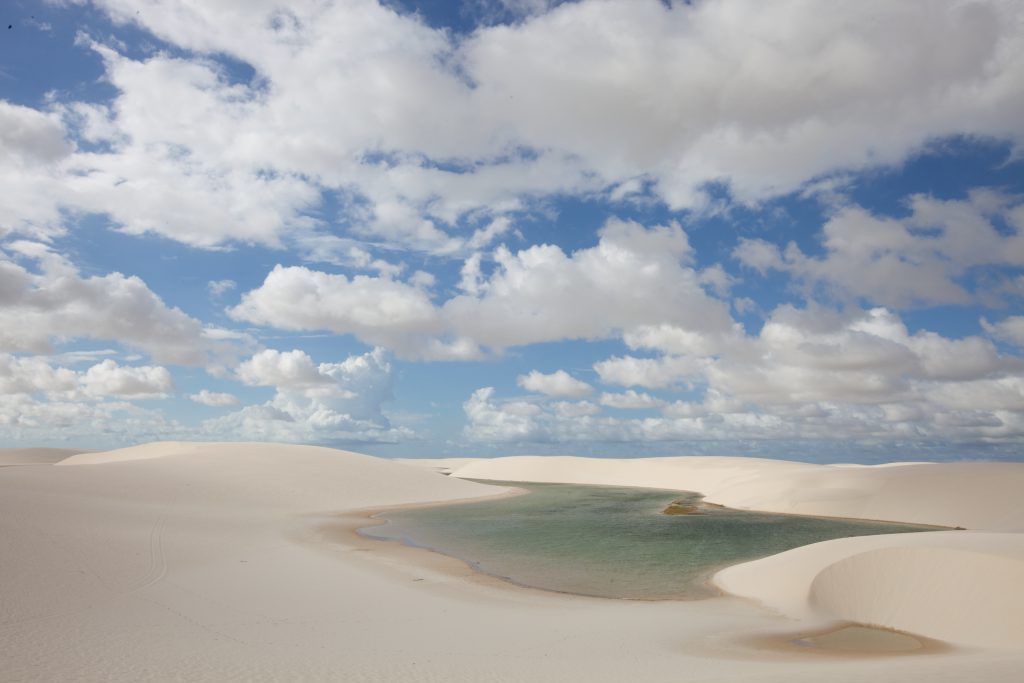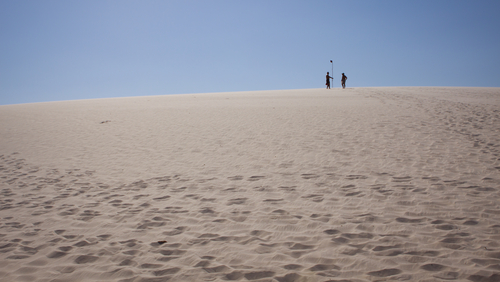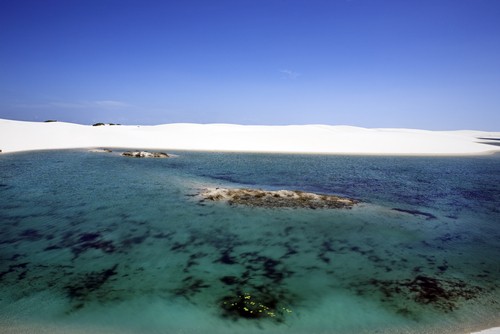
It’s in the enormity of your gaze; it makes me want to lose myself within the sands, and then rediscover myself, and rest forever in the lips of the fresh water… It is this poetic wave that, upon arriving in St. Louis and come across such beauty of Lençóis Maranhenses, you will rediscover yourself.
As well as a part of its natural beauty, sand-dunes are an integral part of the scenery of north-eastern Brazil, but each and every corner, however remote (perhaps because it is so remote) is unique. Each dune has its own special charm.
The first thing you notice is that you are in the middle of a desert, with sand everywhere, like a great white sea in the middle of nowhere! But this is a desert that has an oasis with crystal clear lagoons, whose colours range from turquoise to dark green, and which have the ability to refresh the souls of weary travellers. They lie there in the sun, left there by the rains.
The Lençóis Maranhenses National Park can be found in the semi-arid coastal region in the northern state of Maranhão, about 160 miles from the State Capital, São Luis. It includes the municipalities of Barreirinhas, Primeira Cruz and Santo Amaro do Maranhão. The main gateway to the park is Barreirinhas, which is where the jeep tours and walks begin that lead to attractions such as the Lagoa Bonita and the Lagoa Azul.
To access Lagoa Bonita (“the beautiful lagoon” which lives up to the name) you need to climb a dune that’s over 130 feet high. But don’t worry! There are ropes to help you climb, and anyone who has already done it confirms that it is worth the effort! The Lagoa Azul (“blue lagoon”) is less difficult to access.
The idyllic park scenery covers an area of about 400 thousand acres, and includes some dunes that are more than 130 feet high.
Getting to know a little about the flora and fauna

The flora of the Lençóis Desert has species with many uses; some plants have medicinal properties, some are used for making textiles, and others containing tannin or producing wax or oil, as well as those that produce useful timber.
As regards the fauna, migratory birds like plovers take shelter, terns and boreal, and blue wingedmarreca. The mangroves are home to caimans, brocket deer and large rodents called paca.
An ornithological survey conducted for the park and surrounding areas, recorded 112 different bird species, from 16 different orders and 43 separate families.
The Lençóis National Park has a landscape of natural vegetation which predominantly surrounds the sea of dunes of which it is composed. This vegetation comprises salt marsh, mangrove and alluvial territories, with the salt marsh being the predominant vegetation of the park, comprising 89.4%, while the mangroves account for only 10.2% and alluvial colonies (waterside forests) just 0.4 %.
The best time to visit the Lençóis Desert is between June and September, when the lagoons are full and the scenery is stunning. During the dry season, which runs from October to March, some of the lagoons are completely dry.
Reason for visiting the Lençóis Maranhenses National Park
You could spend hours listing the reasons why this should be an essential experience, but here is just one reason: it’s because the Lençóis Desert resembles heaven on earth so don’t you think it would be unjust not to visit it, don’t you think? Enjoy everything the Northeast has to offer.
Live it up. Try it out. Explore Brazil.



